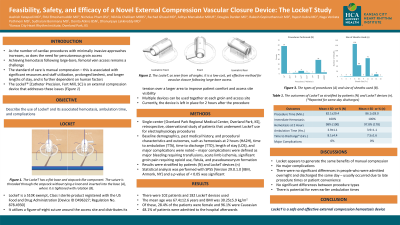Access and Closure
Feasibility, Safety, and Efficacy of LockeT - A Novel External Compression Device Vascular Closure Device

Purpose: Manual compression has been the standard of care for large-bore femoral vein closure but requires bedside staff, prolonged bedrest, and longer length of stay. The LockeT is an external compression device that aims to provide all the benefits of manual compression while addressing its deficits. We present the vascular outcomes of the LockeT following electrophysiologic procedures.
Material and Methods: We performed a single-center, observational study of patients who underwent vascular closure for electrophysiology procedures using LockeT®. Peri- and post-procedural outcomes including sheath size, successful hemostasis, time to ambulation, major and minor complications, and differences between procedures, were subsequently analyzed.
Results: We studied 102 patients (N) for whom LockeT® was used to close 182 separate vascular access sites (n). 98.0% (N=100) used oral anticoagulation, antiplatelet, or a combination of therapy. Common procedures were atrial fibrillation ablation (56.9%, N=58) and left atrial appendage occlusion (28.4%, N=29). Most often, 8-Fr [48.3% (n=126)], 11-Fr[27.2% (n=71)], and 8.5-Fr [16.9% (n=44)] sheaths were used, with an average procedure time of 82.1 ± 29.4 min. Hemostasis was achieved in 97.8% (n=178) of all LockeT cases. Time to ambulation and discharge were 3.93±1.10 hrs. and 8.1±4.4 hrs., respectively. No major complications were noted. There were no differences in hemostasis (p=0.859) or ambulation times (p=0.202) between procedure types.
Conclusions: Several novel yet invasive closure technologies are now clinically used. The LockeT provides a non-invasive yet effective option with high rates of hemostasis and no major complications.
Material and Methods: We performed a single-center, observational study of patients who underwent vascular closure for electrophysiology procedures using LockeT®. Peri- and post-procedural outcomes including sheath size, successful hemostasis, time to ambulation, major and minor complications, and differences between procedures, were subsequently analyzed.
Results: We studied 102 patients (N) for whom LockeT® was used to close 182 separate vascular access sites (n). 98.0% (N=100) used oral anticoagulation, antiplatelet, or a combination of therapy. Common procedures were atrial fibrillation ablation (56.9%, N=58) and left atrial appendage occlusion (28.4%, N=29). Most often, 8-Fr [48.3% (n=126)], 11-Fr[27.2% (n=71)], and 8.5-Fr [16.9% (n=44)] sheaths were used, with an average procedure time of 82.1 ± 29.4 min. Hemostasis was achieved in 97.8% (n=178) of all LockeT cases. Time to ambulation and discharge were 3.93±1.10 hrs. and 8.1±4.4 hrs., respectively. No major complications were noted. There were no differences in hemostasis (p=0.859) or ambulation times (p=0.202) between procedure types.
Conclusions: Several novel yet invasive closure technologies are now clinically used. The LockeT provides a non-invasive yet effective option with high rates of hemostasis and no major complications.
